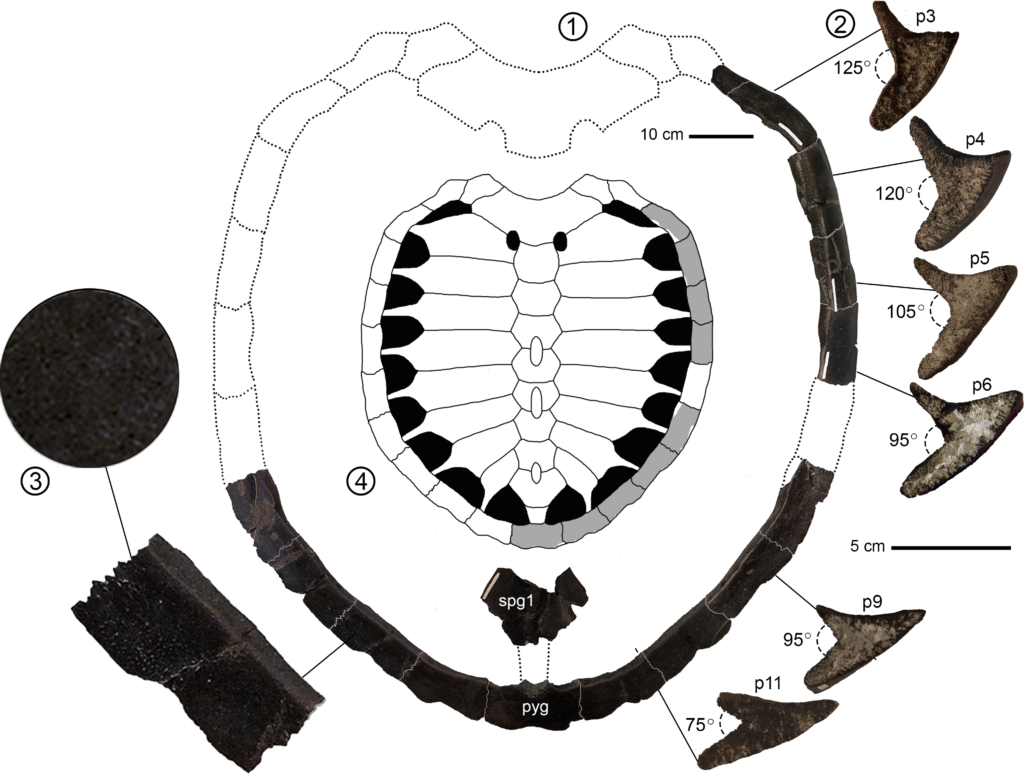@WFS,World Fossil Society,Riffin T Sajeev,Russel T Sajeev
A new species of Peritresius Leidy, 1856 (Testudines: Pan-Cheloniidae) from the Late Cretaceous (Campanian) of Alabama, USA, and the occurrence of the genus within the Mississippi Embayment of North America
Citation: Gentry AD, Parham JF, Ehret DJ, Ebersole JA (2018) A new species of Peritresius Leidy, 1856 (Testudines: Pan-Cheloniidae) from the Late Cretaceous (Campanian) of Alabama, USA, and the occurrence of the genus within the Mississippi Embayment of North America. PLoS ONE 13(4): e0195651. https://doi.org/10.1371/journal.pone.0195651
Editor: Thierry Smith, Royal Belgian Institute of Natural Sciences, BELGIUM

Peritresius martini sp. nov., carapace, ALMNH 6191 (holotype) from the upper Campanian of Alabama, USA.(1) carapace in dorsal view and plastron in ventral view; (2) left peripherals 3–6, 9, & 11 in posterior view; (3) 10X magnified view of the dorsal surface of right peripheral 10; (4) hypothetical reconstruction of the complete shell with the preserved elements shown in gray. Abbreviations: p, peripheral; pyg, pygal; spg, suprapygal.
Late Cretaceous members of Peritresius belong to a diverse clade of marine adapted turtles currently thought to be some of the earliest representatives of the lineage leading to modern hard-shelled sea turtles (Pan-Cheloniidae). Prior studies have suggested that Peritresius was monospecific, with a distribution restricted to Maastrichtian deposits in North America. However, new Peritresius specimens identified from Alabama and Mississippi, USA, show that the genus contains two taxa, Peritresius ornatus, and a new species Peritresius martini sp. nov. These two taxa are characterized by the presence of a generally cordiform carapace with moderately serrated peripherals, well-developed ventral flanges beginning at the third peripheral, squarish umbilical and lateral plastral fontanelles, and a narrow bridge formed by the contact between the hyoplastron and hypoplastron. Peritresius martini sp. nov. can be distinguished by its lack of dermal ornamentation and the presence of a ‘rib-free’ 10th peripheral. These new specimens represent the first occurrences of Peritresius from the Late Cretaceous Mississippi Embayment and extend the temporal range of this genus back to the early Campanian. When tested within a global phylogenetic context, Peritresius is placed on the stem of Cheloniidae (Pan-Cheloniidae) along with Ctenochelys and Allopleuron hofmanni. The heavily vascularized and uniquely sculptured dermal elements of P. ornatus are interpreted here as potentially relating to thermoregulation and therefore may have been one of the key factors contributing to the survival of Peritresius into the Maastrichtian, a period of cooling when other lineages of Campanian marine turtles (e.g., Protostegids, Toxochelys, and Ctenochelys) went extinct.
@WFS,World Fossil Society,Riffin T Sajeev,Russel T Sajeev



 May 6th, 2018
May 6th, 2018  Riffin
Riffin  Posted in
Posted in  Tags:
Tags: 